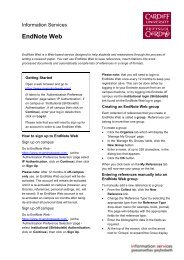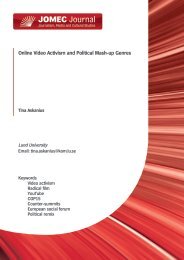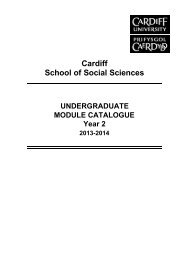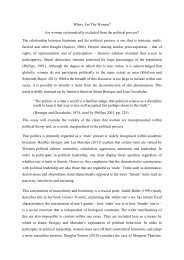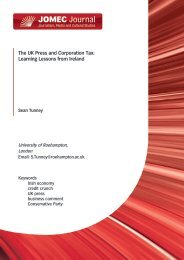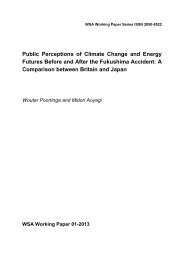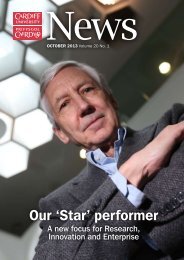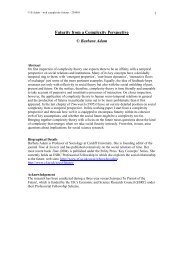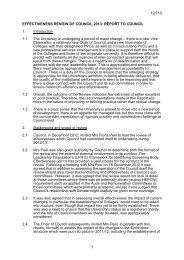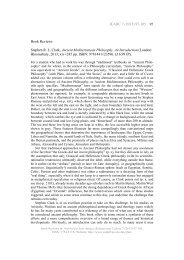APHRODITE IN PROCLUS' THEOLOGY - Cardiff University
APHRODITE IN PROCLUS' THEOLOGY - Cardiff University
APHRODITE IN PROCLUS' THEOLOGY - Cardiff University
You also want an ePaper? Increase the reach of your titles
YUMPU automatically turns print PDFs into web optimized ePapers that Google loves.
JLARC 3 (2009) 21-43 25<br />
pure matter, and in this sense the Neoplatonists accept the Presocratic dictum that<br />
everything is full of gods. 14 The gods of Olympus find their place in the Proclean<br />
hierarchy far below the self-perfected henads, but even they, Aphrodite among<br />
them, are certain manifestations of unity.<br />
Thus the same divinity known by a certain mythological name could be present<br />
and is necessarily present on different levels of reality. 15 Modern research on the<br />
Neoplatonist hierarchy of the gods has located Plato’s lower Aphrodite on the level<br />
of hypercosmic-encosmic gods. Luc Brisson, for example, finds her exactly in the<br />
second term of the fourth triad of the dodecad formed by the hypercosmic-encosmic<br />
deities. 16 It is more difficult to situate the first Aphrodite however. 17<br />
At every level the task of the gods qua gods is to generate, to produce and to<br />
exercise providence towards the universe. 18 Human beings interact with this providential<br />
activity through religious cult and prayer. For Proclus ideal prayer presupposes<br />
precise knowledge of all the classes of gods. 19 We can see a model of<br />
this kind of prayer in the prefaces of Proclus’ main works, which Proclus habitually<br />
opens with a prayer. At the beginning of the Commentary on Parmenides he asks<br />
for appropriate help from each divine class for the reception of the mystical vision<br />
of Plato. 20 However, to understand this correctly: The One and the highest henads<br />
are not receivers of prayers linked with human language. These highest divinities<br />
should be worshiped only transcending intellect in silence and by the unification<br />
prior to silence. 21<br />
things of the world of becoming, mediating for them the illumination of oneness. The supraessential<br />
henads are the gods, whereas the illumination of oneness is a god in each thing and the highest<br />
summit of its existence. This theory is exposed in Proclus, Elements of Theology, ed. Eric R.<br />
Dodds (Oxford, 1963), propositions 2, 6, 64, and 113-162 and the third book of Platonic Theology.<br />
For modern research on the topic see especially the first chapter in the introduction to the latter<br />
work, Saffrey and Westerink, Théologie platonicienne 3 (Paris, 1978), pp. ix-lxxxvii; Christian<br />
Guérard, “La théorie des hénades et la mystique de Proclos,” Dionysius 6 (1982) 73-82, and P.A.<br />
Meijer, “Participation in henads and monads in Proclus’ Theologia Platonica III, chs, 1-6,” in E.P.<br />
Bos and P. A. Meijer, On Proclus and His Influence in Medieval Philosophy (Leiden, 1992), pp.<br />
65-88.<br />
14 Proclus refers explicitly to this dictum in De sacrificio et magia 149, 26 ed. Joseph. Bidez,<br />
Catalogue des manuscrits alchimiques grecs 6 (Brussels, 1928).<br />
15 For clear example of how to understand different stages of the series (here the series of Apollo)<br />
see In Remp. 1.147,6-15.<br />
16 Luc Brisson, “Proclus et l’Orphisme,” in his Orphée et l’Orphisme dans l’Antiquité grécoromaine<br />
(Aldershot, 1995), p. V.86 and How Philosophers Saved Myths (Chicago, 2004), p. 98.<br />
17 I will not try to expound here the whole structure of Proclus’ divine world. Relevant levels<br />
for the location of Aphrodite can be seen in the appended table. For a more synoptic view see the<br />
appendices in Brian Duvick, Proclus, On Plato Cratylus (London, 2007), pp. 173-75, and Hans<br />
Lewy, Chaldaean Oracles and Theurgy (Paris, 1978), pp. 483-85.<br />
18 Theol. Plat. 5.108, 3, ET prop. 120.<br />
19 In Tim. 1.209,9-11.<br />
20 Proclus, In Parm. 617. Both the In Parm. and Theol. Plat. begins with a prayer to the gods and<br />
praising Proclus’ teacher Syrianus.<br />
21 Theol. Plat. 3.30,4-8.<br />
Tuomo Lankila, ‘Aphrodite in Proclus’ Theology,’ in: Journal for Late Antique Religion and<br />
Culture 3 (2009) 21-43; ISSN: 1754-517X; Website: http://www.cardiff.ac.uk/clarc/jlarc



